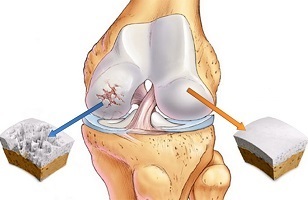
Osteoarthritis of the knee joint is one of the most common joint diseases and is second in severity of the disease after coxarthrosis.
According to recent research, the disease occurs in every fifth adult on earth. In the article we will tell you what are the symptoms of this disease and how to properly treat it to avoid complications.
Causes
Every day a person's knee joints are subjected to stress, because during walking, exercise withstands the entire body weight. Over time, cartilage tissue wears out, leading to changes in the joints. For this reason, older people can get osteoarthritis of the knee joints.
There is also a risk group that includes people:
- overweight;
- suffering from osteoporosis;
- with hereditary disorders;
- elderly people;
- work in specific specialties with a heavy workload;
- have metabolic disorders;
- with a deficiency of microelements in the body;
- with spinal injuries;
- athletes.
It should be remembered that this disease develops quite slowly and it is very important to consult a doctor in time for advice if the main symptoms are found.
This will avoid possible complications such as disability in the future.
Symptoms of osteoarthritis of the knee
To diagnose the disease, just pay attention to the symptoms - they are very common in osteoarthritis. They include:
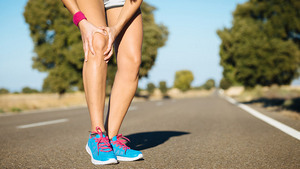
- Pain or discomfort after sleep (or when trying to get up after a long sitting).
- Knee pain when standing for a long time.
- When climbing stairs - burning sensation.
- Night pain or discomfort after a workout.
- Feeling of weakness and "sprain" in the lower limbs.
One of the most important symptoms is pain and pain in the knee area.
In this case, the disease itself does not appear "suddenly": such sensations may intensify for months or years, and at first they will worry only with increased loads, and then the pain will be felt even at rest.
But it is worth remembering that the symptoms vary depending on the degree of the disease.
Let's take a closer look at each option.
I degree
Osteoarthritis of this degree is almost asymptomatic, but there are a number of factors that are characteristic of this phase of the disease:
- feeling of tiredness in the limbs;
- decrease in mobility, which usually occurs after sleep.
If there is pain, it is almost invisible. At this stage it is very difficult to diagnose the disease, so you can not do without an X-ray: osteoarthritis will manifest itself as a small unevenness on the surface of tissues and bones.
II degree
At this "stage" the symptoms are more pronounced. Pain can occur even with a slight strain on the legs, and over time such sensations can occur with simple movement. The discomfort disappears only after a long rest.
Also symptoms such as:
- movement crisis;
- changes in the bones in the joint;
- synovitis;
- inability to bend the legs.
III degree
A characteristic feature of this degree is the severe pain, which no longer depends on the load: the joints can be anxious even at night in the absence of any movement.
Mobility is also impaired - one cannot bend the leg at the knee. Sensitivity to time can also be observed.
Diagnosis and principles of further treatment
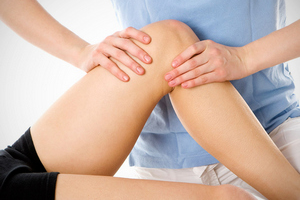
The doctor, after listening to the doctor, will examine the appearance of the knee and assess its mobility. The patient will then be sent for an X-ray and several images can be taken during the treatment period, which will allow to assess the dynamics of the development of osteoarthritis. In some cases, MRI or tomography is prescribed.
If research is needed to correctly determine the root cause of osteoarthritis and to distinguish it from other diseases with similar symptoms.
Treatment usually includes the following:
- Drug therapy.
- Massage and manual therapy.
- Surgical intervention.
- Physical therapy and other methods of rehabilitation therapy.
The main goals of treatment are the following:
- pain relief;
- restoration of the ligament apparatus and destroyed cartilage;
- increased range of motion in the joint.
Massage treatments, physiotherapy and even proper nutrition are also important. If you visit a doctor too late or none of the above methods will help you, surgery will be prescribed: installation of an endoprosthesis.
Treatment of osteoarthritis - choice of methods and means
There are currently groups of drugs that are prescribed to treat osteoarthritis in the early stages:
- NSAIDs - non-steroidal anti-inflammatory drugs;
- chondroprotectors;
- healing ointments;
- compressor tools.
NSAIDs are aimed at eliminating pain and inflammation. And only after the reduction of the pain syndrome can additional treatment begin.
If the use of non-steroidal drugs does not work, especially if the disease only progresses, doctors usually prescribe hormonal drugs.
It is worth remembering, however, that due to a number of side effects, such drugs are prescribed only during the disease - if fluid accumulates inside the joint. The solution is injected no more than once in 10 days.
The only group of agents that directly affect the cause of osteoarthritis are chondroprotectors. They are especially effective in the early stages.
Also in the early stages, hyaluronic acid, which is injected into the joint, is very effective. This procedure is not the cheapest, but it helps to erase the cartilage surface.
When arthrosis is detected, ointments are also prescribed - they also reduce the feeling of pain and eliminate inflammation.
How traditional medicine can help
It should be immediately said that you should not use only methods of traditional medicine - they should be used only as an adjunct to medical treatment.
Let's look at some of the things that can help with osteoarthritis of the knee:
Dandelion flowers
You just need to eat 5 dandelion flowers a day, be sure to rinse them with boiled water. You can also make tinctures: take 5 bottles of dark glass, fill 50% with flowers, fill the container with triple cologne to the neck. Insist for a month, then wipe your knees with the resulting infusion.
Pressing
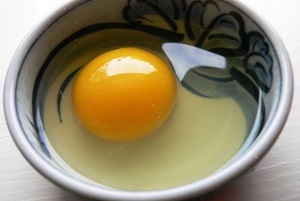
This is a compound that should be rubbed into the knee joint regularly.
It is very easy to make such a composition: take the yolk, mix with 1 tbsp turpentine, add 1 tsp apple cider vinegar. All ingredients should be mixed and left overnight.
Lubricate your knees with the product every night and a woolen scarf on top.
It is also very important to wash the applied mixture well in the morning. To relieve symptoms, you should use this method for 2-3 weeks.
Burdock
According to the folk effects, you should attach 3-4 large burdock leaves to the diseased knee and wrap it with a bandage. Repeat this manipulation for at least a week to relieve the pain. And to enhance the effect, you need to lubricate the joints with cinquefoil oil.
Celery juice
Soak a piece of cloth with juice and place it on the affected knee. After an hour, wash with vegetable oil. Repeat the procedure for a week.
Harpagophytum root
Take 2 tbsp. l. means pour into a thermos, pour 1 liter of boiling water, leave for two hours. Take at least 3 glasses a day in the heat.
Choice of knee pads for osteoarthritis
It is often recommended to wear special knee pads for osteoarthritis of the knee joint, which both reduce the feeling of discomfort and have a healing effect. Usually, if you use them for a short time, you will see improvements such as:
- the inflammatory process decreases;
- the swelling disappears;
- pain relief;
- reduces pressure on the joints;
- The operation of the musculoskeletal system is stabilized.
It is very important to choose the right model that will be effective to wear. To do this, let's first explore what types of knee pads are:
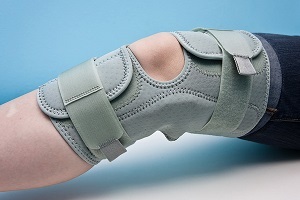
- Open.Essential for those who experience pain after suffering some trauma or mild pain.
- Elastic productswith reinforcing ribs. This type of knee pads are more suitable for those who have pain when squatting, climbing or descending stairs.
- Openadjustable tension knees. Such products are ideal after surgery.
- Closed type- they are used if the source of pain is unclear, ie not concentrated in a specific place. Allows you to minimize stress on the joints.
- The magnetic appearanceof the knee pad is characterized by the presence of a special magnet, thanks to which it has a warming effect, improves blood circulation.
- Hinges.Considered a universal option. Used to minimize pain after injury, osteoarthritis.
In addition to the type, you must also consider the material from which the knee pad is made. So, such elements can be made from:
- Animal fur.These products warm, absorb moisture, reduce inflammation and improve blood circulation in the tissues.
- Polyester.Knee pads made of this artificial fabric are very comfortable, reliable, but do not heat up and are quite expensive.
- Cotton.Nice to wear, waterproof. It is true that there are drawbacks: lack of elasticity and instability of use.
- Nylon.Knee pads made of this material are considered to be the most durable, they fit well to the body. But there is a downside - it's artificial material.
- Neoprene.Despite the fact that it is an artificial material, this material is elastic and has a warming effect. There is also a disadvantage - wearing such knee pads can cause allergies.
But it is important not only to choose the right knees, but also to use them. Doctors give some important recommendations to follow:
- you should not wear them for more than three hours a day;
- the duration of wearing depends on the degree of osteoarthritis - the doctor will inform you in more detail;
- if you have an allergy, you should urgently consult a doctor who will prescribe another dressing;
- it is impossible for the agent to compress the joints strongly;
- wash your knees by hand, the water temperature should not be more than +40 degrees.
In conclusion, it should be said that a healthy lifestyle should not be neglected - in this case the body will function properly. If you feel joint pain, you should urgently consult a doctor to make the correct diagnosis.

























